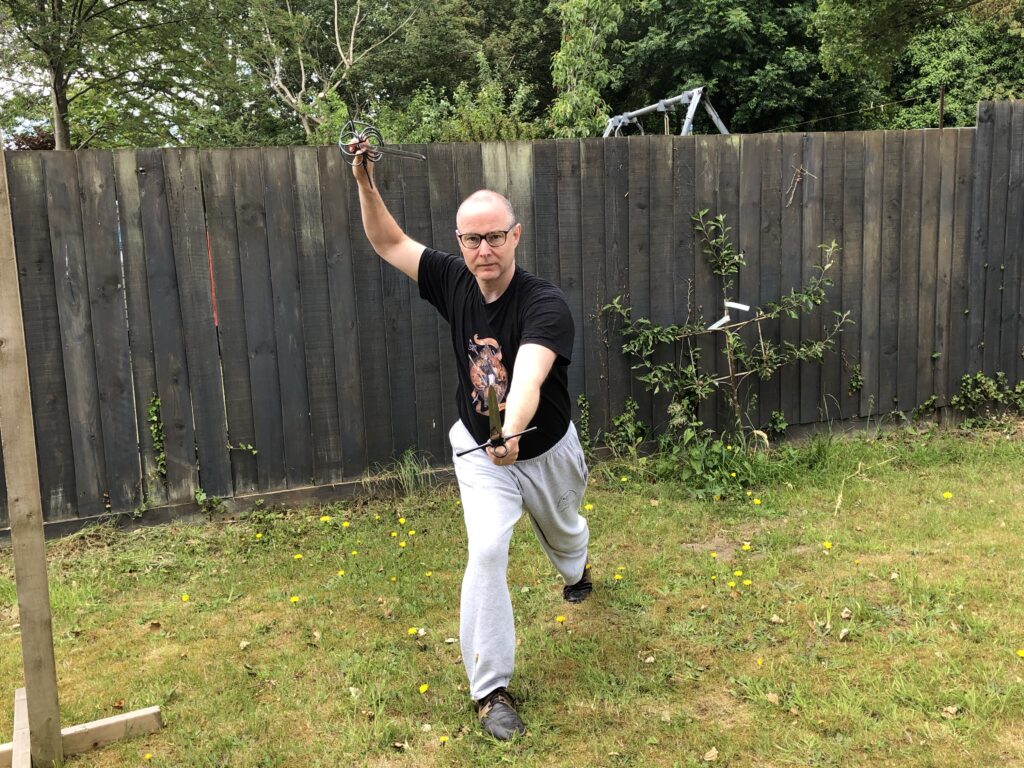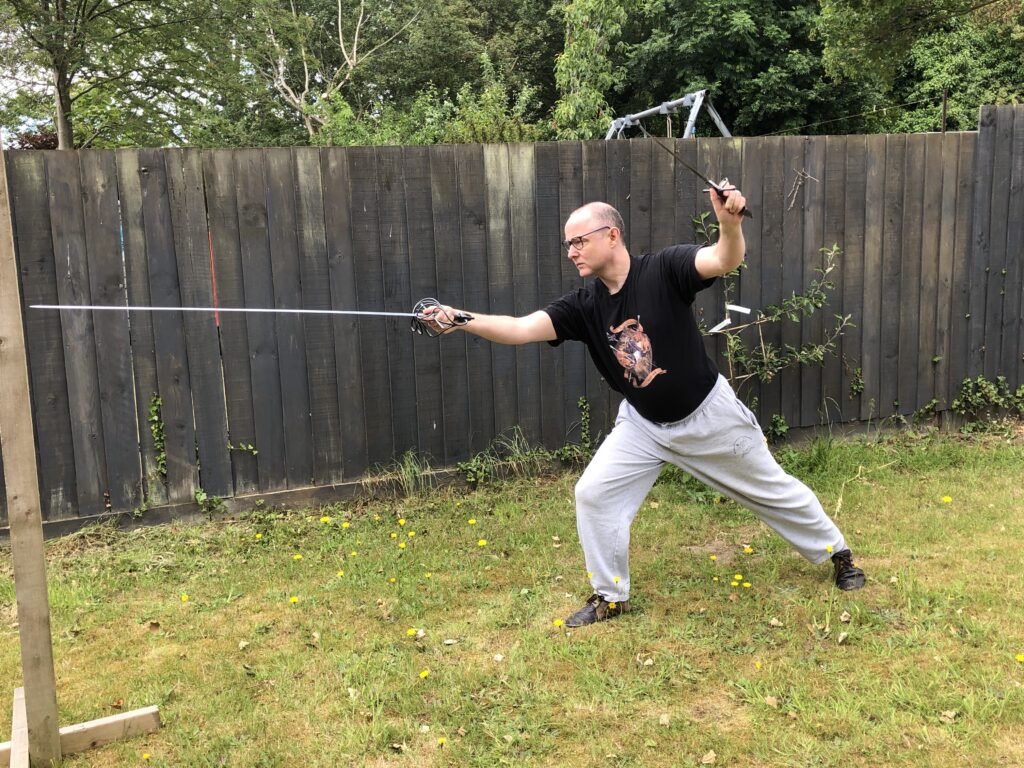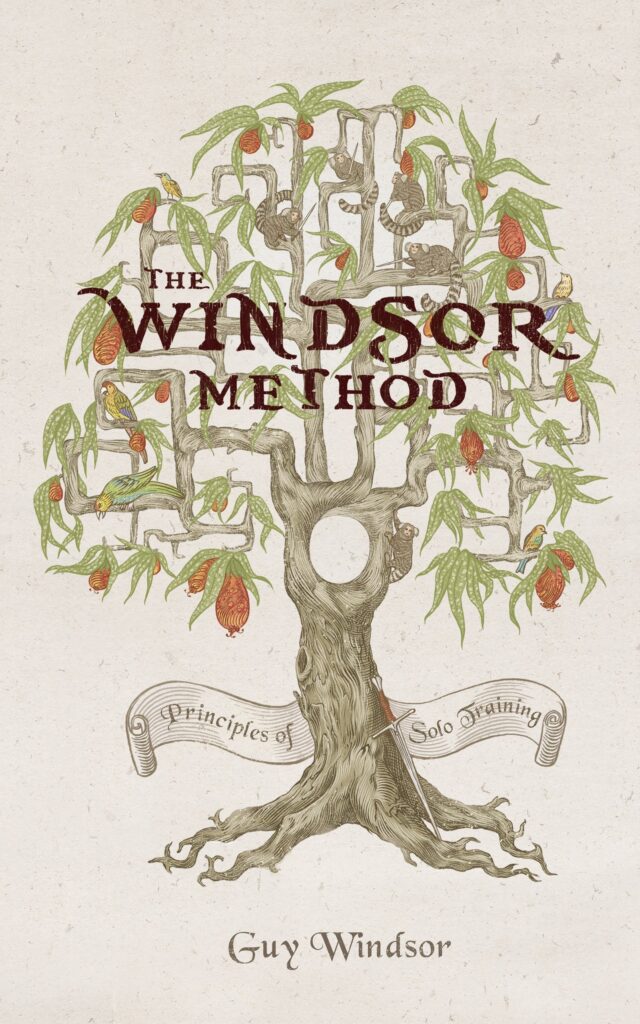Dr. Guy Windsor is a world-renowned instructor and a pioneering researcher of medieval and renaissance martial arts. He has been teaching the Art of Arms full-time since founding The School of European Swordsmanship in Helsinki, Finland, in 2001. His day job is finding and analyzing historical swordsmanship treatises, figuring out the systems they represent, creating a syllabus from the treatises for his students to train with, and teaching the system to his students all over the world. Guy is the author of numerous classic books about the art of swordsmanship and has consulted on sword fighting game design and stage combat. He developed the card game, Audatia, based on Fiore dei Liberi’s Art of Arms, his primary field of study. In 2018 Edinburgh University awarded him a PhD by Research Publications for his work recreating historical combat systems. He runs Swordschool Online, which has over 3000 enrolled students learning historical martial arts over the internet.
The Windsor Method: The Principles of Solo Training is the self-help book for people who want to add years to their life and life to their years. In this refreshingly straight-forward and gentle guide, bestselling author and world- renowned historical swordsmanship instructor Dr. Guy Windsor lays out the fundamental principles behind personal development and excellence in any field.
How? By establishing a solid foundation, and a step-by-step approach to mechanics and training. This is The Windsor Method: use it to guide your practice and elevate your skills.
FMM: When did you discover your passion for martial arts?
I was about six years old when I read The Twelve Tasks of Asterix. One of the tasks is to defeat a judo champion, who’s a tiny little Japanese man. Obelix confidently takes on the challenge and gets absolutely pasted. Asterix responds by asking the judo master to show him his amazing skills, and in the process puts him in a lock… thus defeating him. (Okay, really, he pulls on his arm until a knot appears in it, because this is a cartoon, but you get the idea.) I was entranced by the idea that skill beats size, and that cunning beats skill. The fact that I have an older brother who may not have been always very nice to me could have made that idea very attractive!
This was in Argentina in the ‘70s so there was no martial arts training to be had, but I was bitten by the bug and to their credit my parents supported my obsession and let me take lessons as soon as we found a teacher (which was about three years later).
FMM: You are a world-renowned instructor and a pioneering researcher of medieval and renaissance martial arts. Tell us about The School of European Swordsmanship in Helsinki, Finland.
I got the idea to start researching historical swordsmanship styles in about 1992, after discovering Alfred Hutton’s book The Sword and the Centuries at my Granny’s house (my Grandpa had been a fencer all his life). Soon after that I co-founded The Dawn Duellist’s Society in Edinburgh, and spent most of my free time researching, fencing, and teaching. In 2000, I decided to turn pro and founded the school in 2001. It grew very quickly, with branches opening up all over the place (Sweden, Singapore, Germany, as well as multiple off-shoots in Finland), as interested people came to Helsinki to train with me, then went home and started their own branch. I was also writing books, which helped to spread the word.
I had to move back to the UK for family reasons, so I handed the school over to my students in 2016 and am pleased to say that both the DDS and the School are still running today.

FMM: What is unique about your school?
At the risk of sounding tautological, historical martial arts need to be historical (based on research into historical sources), martial (the techniques you develop from the sources need to actually work) and artistic (they need to be fully worked out systems). The historical sources offer an open window into how the people who actually fought with swords for their lives thought about their martial art. With lineage-based systems, where the art is passed down from master to student over the centuries, the art necessarily changes over time, because every master changes things, at least a little bit. So, if you want to know how people fought 500 years ago, a living lineage is an unreliable guide. But books don’t change.
The research is extremely difficult, of course. It is much easier to learn from a teacher. But after a few decades of effort, we have a pretty good idea of how many different systems of historical swordsmanship work.
FMM: What have you learned about martial arts through your research?
My research has taken me from the early 1300s in Germany, through the Italian Renaissance, and into 18th century France: I have studied very widely and developed a professional level of expertise in medieval sword and buckler, Italian knightly combat, Italian rapier, French smallsword, and other styles and systems. They all use different weapons, optimized for different contexts, but they all have one central approach: control your opponent’s sword, then strike. When you consider that your opponent is trying to murder you with their blade, it makes sense that your first priority is to get their weapon under your control, if only for a moment.
This can be done by physically controlling it, such as by binding it with your sword, or by grabbing their hilt (or even their blade! Yes, it does work, and you don’t get cut if you do it right). Or you can get them to move it in a predictable direction (such as by a feint). But if there is a moment when you can be sure that their weapon is not usable for hitting you, then you can strike.
The differences in specific techniques or styles of movement come from changes to the weapon, and changes to the context in which you would use the weapon. A medieval battlefield is a very different environment to a duelling ground. So, it is vital to think in terms of ‘correct in context’. In other words, the techniques we see in the sources almost invariably work: but only in the right place at the right time with the right weapon. My students come from all walks of life, and in all shapes, sizes, ages and so on. And they all have their own interests. Some are fascinated by a particular historical period, others by a particular weapon, and some are just looking for a fun way to get fit. Because of the breadth of my interests, I can usually find something that works for them.

FMM: Tell us about the fascination with your Swordschool Online?
Have you ever been faced with needing to do something, but you don’t know how, so you fire up YouTube and find a useful video of some kind soul telling you exactly how to do it?
Of course. Everybody has. And while there is no substitute for having a trained mechanic telling you how to get your car started, or indeed a teacher there in the room with you helping you get your sword work right, video is by far the best medium for teaching movement.
So, in 2016 I started producing online courses, so my students can learn without having to fly me to wherever they are.
Most martial arts classes consist of the teacher showing you what to do, then you go do it for a while, then they make corrections and you practice some more, and then perhaps they show you the next thing. You actually learn the skill itself from the person you are crossing swords with- that’s not usually the teacher.
I built my online classes to follow the pattern of normal training sessions- indeed some clubs open one of my video classes on a laptop in their training hall and let me teach the class for them!
So far, we have complete courses on Medieval Longsword, Medieval Dagger, Medieval Sword and Buckler, the Rapier, Solo Training (how to practice usefully by yourself), as well as shorter courses doing a deep dive into Breathing training, Meditation for martial artists, Footwork, the Research side of historical martial arts, and our free Human Maintenance course (which includes sections on looking after your joints, and some meditation and breathing too).
I’m currently working on How To Teach, which should be ready in September ’22. Some students buy the courses individually, and some prefer to get access to everything through a monthly subscription.
FMM: What are students saying about your site?
David in Canada wrote this about my Medieval Longsword and Medieval Dagger courses:
“Since I don’t have an HMA club near me, these online courses have been very helpful in guiding my friend and I as we begin practicing together. The videos are very conversational and feel much like being in an actual class where Guy explains the theory behind what he’s doing as he’s demonstrating it. The courses are structured so that they progress from basic to more complex material in a way that holds your hand and provides specific solo and pair drills at first, while that is what you need, and gradually transitions to covering principles and examples for self-guided study as the learner’s skill level increases. If you can’t find an HMA club near you, this is a great way to start studying on your own, and if you are already part of an HMA club, these video courses can be a great resource to supplement, or be a good starting point for developing, your own curriculum.”
Riri in Indonesia wrote this about the Breathing course:
“I can feel the benefits of this course directly. There’s this exercise video I have that I really like, but it had been very difficult to follow. I had to pause it regularly to catch a breath, and I would end up feeling overly exhausted if I could finish it at all. But after I took your breathing course, I began to be aware of my breath in the sense that I know and don’t forget to inhale and exhale (apparently, you can forget to breathe when doing exercise). Now, I can easily follow the exercise video and feel fresh afterward instead of feeling like I’ve been run over by a truck.”
Mikko in Finland wrote this about my Recreate Historical Swordsmanship from Historical Sources course:
“When I had the chance to be one of the first to participate in Guy Windsor’s online course on how to recreate historical swordsmanship from historical sources I jumped right in. I had studied with Guy and already knew he had done a great job over two decades in researching original sources on historical swordsmanship and fighting and used his research to reconstruct systems of fighting with different weapons, so I trusted that he knew what he was talking about here.
I was interested in sword and buckler fighting and wanted to dig deeper into all the different sources and styles of fighting with sword and buckler. The online course met and exceeded my expectations. In addition to learning how to approach and interpret the sources in meaningful manner it also taught me how to actually put together a whole system based on a source and, even more important, how to design drills and a syllabus to teach the system to others.
So far I have used the lessons learned from this course to build a core curriculum for an introduction to sword and buckler fighting and have taught this curriculum to at least five other people.
In addition to this the course helped me to approach the sources in systematic and logical manner so my knowledge of the context in which the sources were written and the culture for which they were written has increased dramatically. Whether you are planning to reconstruct a whole system of fighting from sources, building a curriculum and drills to teach an existing system or just want to learn more about how to interpret historical sources and use them to build drills I can recommend the course to you!
FMM: You have written several books. Take us through your work.
There are several aspects to recreating a historical martial art, beginning with finding the sources and making them available, then academic analysis of the sources, then producing a training method from the analysis, and ending with developing advanced fencing skills that work under pressure.
Let’s imagine you’d like to be able to fight with a medieval longsword. The best source for that is Il Fior di Battaglia, by Fiore dei Liberi, which was written in about 1400. I have produced a facsimile of the source, so you can study it directly.
But maybe you can’t read 15th century Italian, or 15th century Italian handwriting? Then my book From Medieval Manuscript to Modern Practice: The Longsword Techniques of Fiore dei Liberi would be helpful. In that, I transcribe the original Italian, translate it into English, then discuss how I think the technique should be done, and provide a link to a video of me or my students actually doing it.
That tells you exactly what the book says, and how the techniques work. But it doesn’t tell you how to organize those techniques into a working syllabus, or how to develop your fencing skills. For that we have The Medieval Longsword, which leaves out most of the academic stuff, and just tells you what to do to learn the style. I’ve also produced The Armizare Workbook which takes the idea of a training manual to the next level: the book has space for writing your notes (and comes in two formats, laid out for left or right handed students), but most critically a QR code for every video, so you just point your phone at the page and you can see the action come alive. It’s also organized in such a way that you get to choose the order in which you approach the techniques. This encourages students to become more self-directed.
Most of my readers go with The Medieval Longsword or The Armizare Workbook because they just want to learn to fence. Some go with From Medieval Manuscript to Modern Practice, because they are interested in why we fence that way. And some decide they want to learn directly from the Master, so go with the facsimile. Of course some students start out with an academic interest and get seduced into the training, while others start out just wanting to swing swords and hit their friends, and get seduced into the history.
FMM: You just launched your book, The Windsor Method: The Principles of Solo Training. Share some of your expertise offered in this book.
The book was triggered by one of my students who had a health problem that meant he couldn’t do any physical training for six weeks. What could he do? So I introduced him to various kinds of meditation. It occurred to me that most of my community simply don’t know how to develop themselves other than show up to classes and have someone tell them what to do. I wrote the book so that no matter what situation you find yourself in, there is something that you can be doing to help you get closer to your goals. Every body is different. Every mind, too. The great advantage of training alone is that you can tailor your efforts to your specific needs. The message of the book is “find out what works for you, then do that”. Easier said than done! Which is why I go into such diverse topics as mindset, mental health, food, sleep, and physical conditioning. It is not a collection of solo sword exercises- it’s a manifesto on how to create the person you want to be out of the person that you currently are, through deliberate practice.




